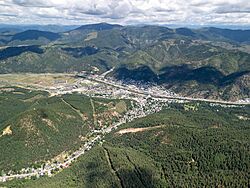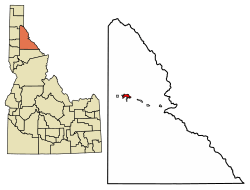Kellogg, Idaho facts for kids
Quick facts for kids
Kellogg, Idaho
|
|
|---|---|

Drone view from Kellogg, Idaho
|
|

Location of Kellogg in Shoshone County, Idaho
|
|
| Country | United States |
| State | Idaho |
| County | Shoshone |
| Area | |
| • Total | 4.01 sq mi (10.39 km2) |
| • Land | 3.97 sq mi (10.29 km2) |
| • Water | 0.04 sq mi (0.09 km2) |
| Elevation | 2,494 ft (760 m) |
| Population
(2010)
|
|
| • Total | 2,120 |
| • Density | 537.49/sq mi (207.52/km2) |
| Time zone | UTC-8 (PST) |
| • Summer (DST) | UTC-7 (PDT) |
| ZIP code |
83837
|
| Area code(s) | 208, 986 |
| FIPS code | 16-42580 |
| GNIS feature ID | 2410173 |
Kellogg is a city located in the Silver Valley area of Shoshone County, Idaho, in the Idaho Panhandle region. It's found near the Coeur d'Alene National Forest. The city is about 36 miles (58 km) east-southeast of Coeur d'Alene along Interstate 90. In 2010, about 2,120 people lived there.
Contents
A Look at Kellogg's History
Kellogg became an official city in 1907. It was named after a prospector called Noah Kellogg. The city quickly grew into a major center for silver mining. For almost 100 years, mines in the area produced a lot of silver.
Mining and Workers' Rights
During the mining years, there were often disagreements between the miners and the mine owners. Workers wanted better conditions, including fair pay and safer workplaces. One important mine was the Bunker Hill Mine. It closed in 1981. This meant thousands of people lost their jobs. The mining operations also caused lead pollution in the water and soil nearby. Other mines in the area also slowed down their work.
From Mining to Mountain Resort
After the mines closed, Kellogg started to change. It began to focus on tourism, using its beautiful mountains for skiing and other fun activities. By 1990, a long track was built. This track allowed people to ride a gondola from Kellogg up to a ski lodge on Kellogg Mountain. The ride is about 3.1 miles (5 km) long.
Today, Kellogg is home to Silver Mountain Resort. This resort has condos, hotels, restaurants, shops, a water park, and a golf course. In 2008, The New York Times even featured Kellogg as an exciting new resort town. Silver Mountain Resort has two main peaks: Kellogg Peak (6,297 feet) and Wardner Peak (6,200 feet). You can reach them using one of the world's longest single-cabin gondolas!
The Sunshine Mine Accident
In May 1972, the Sunshine Mine in Kellogg experienced a terrible accident. A fire broke out, causing the deaths of 91 miners. Eight days after the fire started, two miners were found alive. They had survived near a fresh air source deep inside the mine. Everyone else trapped in the mine had died.
After this accident, the government created new safety rules for mines. Now, every miner in the U.S. carries a "self-rescuer." This is a special breathing device that helps miners avoid carbon monoxide poisoning. The Sunshine Mine stayed open until 2001. It produced a huge amount of silver, about 360 million troy ounces (11,000,000 kg). As of 2005, a company called Sterling Mining has plans to explore and develop the mine further.
Kellogg's Geography
The city of Kellogg covers about 4.01 square miles (10.39 square kilometers). Most of this area is land, with a small part being water.
Kellogg's Climate
Kellogg has a mix of a dry-summer continental climate and a cold mediterranean climate. This means it can have very hot and very cold temperatures, even though the average temperatures are quite mild. For example, the hottest temperature ever recorded was 111°F (44°C) in August 1961. The coldest was -36°F (-38°C) in December 1968.
The temperature changes a lot between day and night in the summer. This means that warm summer nights are rare. The warmest night ever recorded was 74°F (23°C) in June 2015.
| Climate data for Kellogg, Idaho, 1991–2020 normals, extremes 1905–present | |||||||||||||
|---|---|---|---|---|---|---|---|---|---|---|---|---|---|
| Month | Jan | Feb | Mar | Apr | May | Jun | Jul | Aug | Sep | Oct | Nov | Dec | Year |
| Record high °F (°C) | 58 (14) |
68 (20) |
78 (26) |
93 (34) |
101 (38) |
107 (42) |
109 (43) |
111 (44) |
104 (40) |
92 (33) |
69 (21) |
61 (16) |
111 (44) |
| Mean maximum °F (°C) | 49.3 (9.6) |
52.5 (11.4) |
65.1 (18.4) |
74.9 (23.8) |
85.8 (29.9) |
91.9 (33.3) |
97.5 (36.4) |
96.7 (35.9) |
88.4 (31.3) |
74.7 (23.7) |
58.0 (14.4) |
49.5 (9.7) |
99.2 (37.3) |
| Mean daily maximum °F (°C) | 37.0 (2.8) |
41.5 (5.3) |
49.6 (9.8) |
57.8 (14.3) |
68.6 (20.3) |
74.7 (23.7) |
84.9 (29.4) |
84.3 (29.1) |
73.4 (23.0) |
58.0 (14.4) |
44.1 (6.7) |
36.3 (2.4) |
59.2 (15.1) |
| Daily mean °F (°C) | 29.3 (−1.5) |
32.0 (0.0) |
38.4 (3.6) |
45.0 (7.2) |
54.2 (12.3) |
60.4 (15.8) |
67.7 (19.8) |
66.6 (19.2) |
57.2 (14.0) |
45.2 (7.3) |
35.6 (2.0) |
29.0 (−1.7) |
46.7 (8.2) |
| Mean daily minimum °F (°C) | 21.7 (−5.7) |
22.6 (−5.2) |
27.1 (−2.7) |
32.3 (0.2) |
39.6 (4.2) |
46.0 (7.8) |
50.5 (10.3) |
48.8 (9.3) |
41.0 (5.0) |
32.5 (0.3) |
27.1 (−2.7) |
21.8 (−5.7) |
34.3 (1.3) |
| Mean minimum °F (°C) | 5.0 (−15.0) |
9.8 (−12.3) |
17.7 (−7.9) |
25.5 (−3.6) |
30.4 (−0.9) |
37.6 (3.1) |
43.0 (6.1) |
40.6 (4.8) |
32.4 (0.2) |
22.1 (−5.5) |
15.8 (−9.0) |
7.0 (−13.9) |
−0.7 (−18.2) |
| Record low °F (°C) | −27 (−33) |
−26 (−32) |
−9 (−23) |
6 (−14) |
20 (−7) |
30 (−1) |
31 (−1) |
28 (−2) |
11 (−12) |
0 (−18) |
−11 (−24) |
−36 (−38) |
−36 (−38) |
| Average precipitation inches (mm) | 4.29 (109) |
3.06 (78) |
3.66 (93) |
2.89 (73) |
2.88 (73) |
2.73 (69) |
1.15 (29) |
0.82 (21) |
1.32 (34) |
3.11 (79) |
4.55 (116) |
3.45 (88) |
33.91 (861) |
| Average snowfall inches (cm) | 15.1 (38) |
12.0 (30) |
6.4 (16) |
0.7 (1.8) |
0.0 (0.0) |
0.0 (0.0) |
0.0 (0.0) |
0.0 (0.0) |
0.0 (0.0) |
0.0 (0.0) |
4.4 (11) |
13.8 (35) |
52.4 (131.8) |
| Average precipitation days (≥ 0.01 inch) | 18.0 | 15.3 | 17.2 | 16.4 | 13.9 | 11.7 | 5.8 | 5.0 | 6.9 | 12.8 | 17.8 | 18.1 | 158.9 |
| Average snowy days (≥ 0.1 in) | 8.9 | 6.5 | 3.6 | 0.8 | 0.0 | 0.0 | 0.0 | 0.0 | 0.0 | 0.1 | 3.0 | 9.5 | 32.4 |
| Source 1: NOAA | |||||||||||||
| Source 2: National Weather Service | |||||||||||||
People Living in Kellogg
| Historical population | |||
|---|---|---|---|
| Census | Pop. | %± | |
| 1910 | 1,278 | — | |
| 1920 | 3,017 | 136.1% | |
| 1930 | 4,124 | 36.7% | |
| 1940 | 4,235 | 2.7% | |
| 1950 | 4,913 | 16.0% | |
| 1960 | 5,061 | 3.0% | |
| 1970 | 3,811 | −24.7% | |
| 1980 | 3,417 | −10.3% | |
| 1990 | 2,591 | −24.2% | |
| 2000 | 2,395 | −7.6% | |
| 2010 | 2,120 | −11.5% | |
| 2020 | 2,314 | 9.2% | |
| U.S. Decennial Census | |||
2010 Census Information
In 2010, there were 2,120 people living in Kellogg. These people lived in 903 households, and 526 of these were families. About 29.8% of households had children under 18 living there. The average household had about 2.29 people. The average age of people in the city was 40.4 years old. About 24.4% of residents were under 18.
Getting Around Kellogg
Bus service to and from Kellogg is provided by Jefferson Lines.
Images for kids
-
1907 Geologic map of Kellogg, showing mine locations
See also
 In Spanish: Kellogg (Idaho) para niños
In Spanish: Kellogg (Idaho) para niños





